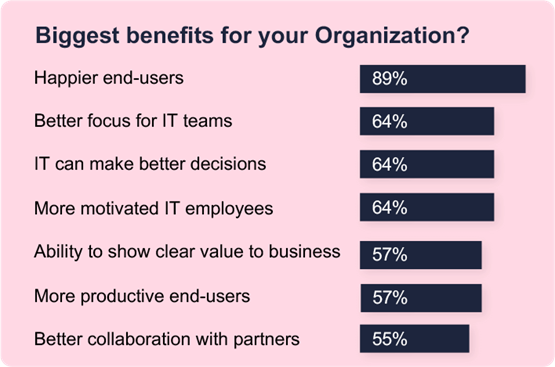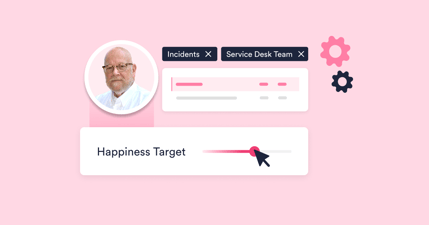Here's the scenario: You've heard about employee experience being applied to IT and that it can be helpful to your organization, but you also hear that senior management isn't convinced that you should be spending time, effort, and money measuring and managing it. When you look into the ITXM Framework™ more deeply, it becomes apparent that the organization can benefit from its application. Now, you need to find some way to convince the skeptics that it will work and produce beneficial effects. Where do you start?
Let's look at three significant objections:
- We already know what's best
- It's subjective
- Return on Investment (ROI) is difficult to track.
How we can overcome these objections
We already know:
Many organizations forego employee experience measurement because the management feels they "know best" what's good for the employees and the company. Whether we look at the lean management practice of the Gemba Walk or watch an episode of Undercover Boss, we can see the value of hearing directly from employees doing the work. Employee feedback often provides a view into improvements that management would not otherwise see. Being the ones who are hands-on, employees—the consumers of your organization's IT services—can point to specifics in their technical environment that can sap their time and effort, lowering both productivity and satisfaction.
It's important to remember that IT looks at and responds to interruptions of service or service degradations (that is, Incidents) but not processes or procedures that tend to slow the work down or make it more difficult for those doing it. (See How to use ITXM™ to Identify Improvement Areas in IT)
It's subjective:
Whether it's customer satisfaction for your products and services or an Amazon rating, every survey reflects a subjective opinion. The questions themselves ask for opinions. The key here is not that the individual responses matter; it's what we learn from the collected responses. That's why results are reported in percentages. It's one thing if 5% of your employees say they are struggling with your enterprise applications. It's something else entirely if 85% say so.
ROI is difficult to track:
Companies want to realize ROI as rapidly as possible, but the timelines tend to be longer when tracking and analyzing the return on experience management. The return, however, should be clear.
- Positive effects on employee retention:
- Working in an organization that listens to feedback and—most importantly—acts on that feedback positively affects employee retention. Qualtrics says, "…Intent to Stay is one of the 5 KPIs we look at when assessing the quality of employee experience…"
- The financial costs of employee churn are high. From Oracle: "The Society for Human Resource Managementputs the average cost per hire at nearly US $4,700. While the specific cost may be up for debate, the bottom line is that recruiting costs money, time, and expertise that could be spent more strategically if employee retention rates were higher."
- But that doesn't tell the entire story. A 2022 Wharton School study showed the link between employee turnover in smartphone production and subsequent product failures. That study showed that "Each percentage-point increase in the weekly turnover rate for workers increased product failure by 0.74% to 0.79%" and that "The associated costs amounted to hundreds of millions of dollars."
- Reduced disruption:
- The author of the Wharton study stated, "What we find from the data is that if you take an experienced person who left the line and find an equally experienced person and plug them in, it's disruptive. That person who left has some knowledge that's not easily replaced…"
- In any setting, having to shift work from a departing employee to one who is staying and already working at a high level, even temporarily, can have disruptive effects. Retaining employees reduces this type of disruption.
- Better employee experience has also been shown to reduce absenteeism.
- Better customer experience:
- Employee experience has effects beyond internal operations, too. In the report Uncovering the Significant HR Trends of 2024 to Maximize Your Next-Best Step, HR tech company isolved says, "Ninety percent of employees say the experience they have as an employee influences the experience they provide customers."
- In an IDC study in 2021, "… 62% [of respondents] said that there is a defined causal relationship between EX and CX and that the impact was 'large' or 'significant' and measurable."
- Better business performance:
- Employee engagement is one aspect of the overall employee experience. According to Microsoft, "Research shows that organizations that doubled down on employee engagement in times of economic uncertainty performed twice as well financially as organizations that deprioritized it—with the most engaged outperforming the S&P 500 at the end of the year. On average, each additional point of engagement reported by employees correlated with a +$46,511 difference in market cap per employee."
In other words, Research shows that investment in employee experience can positively impact many aspects of the organization, from employee retention to stock performance, and the results are measurable. Once the organization acknowledges the correlation of employee experience to retention, customer experience, and financial performance, the ROI on the investments required can be demonstrated.
Coming back to ITXM
To refocus specifically on employee experience as it relates to IT, we can start by stating the obvious: Much of the work employees do in 2024 (and will do in the future) depends heavily on the organization's information systems, tools, and support. IT incidents, whether they occur to individuals, departments, organizations, or—as recently seen—globally, can have devastating impacts on productivity. ITXM can provide a detailed look into where, when, and how employees feel these impacts and help direct improvement efforts to address the things that matter most to those employees.
ITXM is delivering general benefits to many organizations right now.

2023 HappySignals Customer Survey
ITXM's ability to bring better focus has provided insights such as those from The Global IT Experience Benchmark Report: Full Year 2023: "When IT identifies where end-users are losing time, they will find improvement opportunities that greatly impact every issue that gets solved. Understanding where people lose only small amounts of productive work time allows IT to identify automation candidates that would liberate time from agents to solve more complicated issues."
As we head into the era of Artificial Intelligence, we can even apply ITXM to assist us in planning the best areas to get AI-enabled tools in place.
Shouldn't your organization be reaping the benefits of measuring IT experience?





